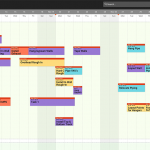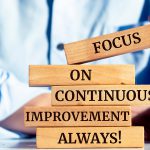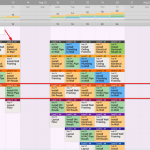Katherine Van Adzin: Today we’re talking about profit velocity! To start off, could you define what it is?
Hal Macomber: So, most people understand that you make a given amount of money in a certain period of time. We make X amount a year or we make X amount a quarter or we make X amount a day. And the rate at which we’re accumulating profits is called the profit velocity. Now, people think about that at a company level. But in construction, we also want to think about it on a project level. How fast is this project making money?
So, if you have a ten-month project that is going to make $200,000, your profit velocity per month is $20,000. And if you’re looking at two projects you might realize that you only have the staff to do one of them. One of them is a $200,000-profit job and the other is a $250,000-profit job. You might immediately think that you should take the $250,000-profit job. But wait a minute. What’s the profit velocity?
The first project is ten months, so that profit velocity is $20,000/month. The second project is twenty months, so that profit velocity is $12,500/month. It’s a worse deal to take the job with a higher profit. Most people don’t do that analysis. They say, “What’s the margin on this? It’s $250,000. What’s the margin on that? It’s $200,000. Great, take the $250,000.”
They might also look at the project durations and think that the second one will keep people busy for twenty months, as opposed to the first one that only keeps them busy for ten. But they don’t run the calculations. One of the reasons this is important is you don’t get to do a construction project without an experienced superintendent and an experienced project manager. And while everybody has to have their first shot at a bigger project, junior PMs are highly supervised on their first projects. And the same goes for junior superintendents. So, even when you have a project that’s being run by a rather junior person, they’re getting a lot of supervision, or at least a lot of support from senior people. Now you’re spreading senior people quite thin and you want to be making a lot of profits. You want to have a very high profit velocity if you need to do something like that.
The choice boils down to this: we can make $20,000/month profit velocity using a PM, or we can make $20,000/month and use a senior PM. So maybe you then go one step further and you say, okay, this job that’s going to make $200,000 profit is going to need a senior PM and a senior superintendent. But this project that’s going to last longer and only make $12,500 profit velocity is going to be an easy project that could use two junior people. When you have a choice, consider the profit velocity based on the resources needed to deliver that project.
If you want to change the whole way you go after work and assign people to work, you need to think about both profit velocity and the critical staffing for the project. Always critical are the PM and super. On a very technical healthcare project, you’d put in a second superintendent or a second project manager specifically for mechanical, electrical, plumbing, fire protection, etc. Now you need three or even four more people to do projects like that.
KV: What kinds of things affect the profit velocity? What will make it higher on one project than another?
HM: When you sell your project, there’s a delta between what the project’s worth to the owner and what it costs to deliver it. And sometimes that delta’s pretty slim. Sometimes it’s only one percent between the total cost of the project and what the market will pay for that work. Sometimes it’ll be as much as three or four percent, those are typical construction margins. I’m not talking about architecture or engineering at this point. But it depends on how you put the project together. To the extent that you can shorten the project, you will dramatically boost profits.
Let’s say we have a ten-month project where we’re going to make $200,000. So it has a profit velocity of $20,000/month. It turns out that profits are often the same order of magnitude as general conditions. So if you’re making $20,000 a month in profit, you’re probably also paying $20,000 a month keeping the jobsite operating, between renting the fences, renting the porta-potties, having internet service, and maintaining minimal staff. You’re going to have general conditions at least equal to it. And most of the time, if you need more than minimal staff, your general conditions will be twice what you’re making in profit.
Let’s say we take a project that has $20,000 a month profit velocity, and has $40,000 a month in general conditions. If we turn that ten-month project into an eight-and-a-half-month project, because what we’re seeing when you use the Last Planner® System and you design for flow, your projects are three weeks shorter for every five months on your schedule. So we have a ten-month schedule, and we’re going to reduce it by six weeks. Now we’re going to make $200,000 in eight-and-a-half months. But we’re going to add to that.
We’re going to add an additional $60,000 savings from overhead, of general conditions because we’re not spending it. The project is shorter, so we’re not going to spend that money. And if it’s a fixed price contract, now our profit goes from $200,000 in ten months to $260,000 in eight-and-a-half months. Doing the math, $260,000 divided by eight and a half is around $30,500. So our profit velocity is going to increase by over fifty percent, even though we’ve only cut the duration by fifteen percent. That’s a really big deal!
Finding ways to intentionally cut the duration, and especially using the Last Planner System®, positions you to get a shorter project, and that’s a higher profit velocity.
KV: What are the best ways to shorten a project’s duration?
HM: With the Last Planner System®, if each trade is reliably performing work for their customers, meaning the next trade in line, and you’re working to a takt time paced production, you get a pretty short project, easily twenty-five percent shorter, just doing that.
But there are ways to go further, and one of the best ways is through off-site construction. Doing things like prefabrication, pre-assembly, and kitting to uncouple work from the jobsite back into the trade shops helps reduce duration further. They still have all those hours to do it, but let’s just talk about electrical work as an example. The electrician does a lot of things to power a building. And one of them is to power all of the mechanical devices in the building, including everything to do with the HVAC system. Normally you do the HVAC install and then the electrician runs the cable, runs the conduit, runs the low-voltage control lines, and you do all that stuff in the jobsite. But what if you did some of that off-site? You wouldn’t be spending all that time on-site.
So, one of the things that better electricians are doing as standard work is they’re kitting. They’ll kit based on the building information model, the cable lengths, the conduit lengths. They’ll prefabricate it. They’ll bend the conduit. They’ll make lots of conduits, so they’ll pre-assemble it. And they’ll do all this in their shop while the mechanical contractor is installing on-site. Now when it’s time to install the electrical, all of that fabrication and assembly has been done, so all they need to do is install. And installation takes far less time than fabricating and assembling, so now the electricians are on-site for less time.
So now instead of six weeks shorter, you’re going to pick up two, three, or four more weeks when you look at all the trades that can do some of the work off-site concurrently while other people are working on-site. Last Planner® is about managing and designing your production system for flow or flow efficiency and doing off-site construction makes for dramatically shorter projects, which means even with the same amount of profit, you have dramatically better profit velocity.
Most trades are on some path to doing more and more work off-site. We’re in a transition right now. The companies that are doing a really good job with building information modeling are doing it to take advantage of off-site construction opportunities.
KV: What cultural and organizational changes can you make to increase profit velocity?
HM: Well, the first one is off-site construction. Often when I ask the construction manager’s project team, “So what’s your off-site construction strategy?” they look at me and they say things like, “Well, we leave that up to the trades.” You don’t want to leave something with that big of an impact on safety, quality, and profit velocity to the individual decisions of the trades. It needs to be a tactical decision that the general contractor or construction manager makes.
If you have the construction manager’s early involvement in the design process, you want to know really early what you plan to do for off-site construction so that the engineers take that into consideration when they’re doing the engineering. In addition to that, you have to pay attention to the laws of production, the batching and queuing (Little’s Law), variation and the law of bottlenecks. It’s important to pay attention to these things so that you’re maximizing your flow efficiency, yet most project teams aren’t paying attention to them, let alone measuring them, let alone improving on them on a weekly basis.
This is one of those situations where using software really helps. Being able to operate very early with data without having any additional effort to create data reports or to do analysis of data allows you to immediately take actions that improve flow efficiency. But to do that you need to know that flow efficiency is something you should pay attention to in the first place.
So if you know about profit velocity and you understand flow efficiency, you absolutely have to be using the Last Planner System® with software because that makes you the most responsive to both what’s occurring that’s different from what you thought and to your learning. It ensures that you won’t miss opportunities to take the kinds of actions that improve flow efficiency on a timely basis and therefore profit velocity.
KV: How common is it for companies to be planning in this way?
HM: Project executives, in large part, don’t grasp the significance of the Last Planner System® on their financial performance. They haven’t put it all together. I make sure they do understand from the beginning when I work with them because that keeps them engaged. That keeps them providing the leadership that’s needed.
KV: Are there any sort of benchmarks that you use in terms of how much a company should be trying to improve?
HM: First of all, make sure you look at what’s the best performance that we’re seeing in your type of building and use appropriate benchmarks for the variety of work that you do. I use quality as one of the characteristics that we should be paying attention to. Lean projects should have very small punch lists. And I don’t mean small because they’re punching as they go—I mean that the work that they’re putting in place was done so correctly (maybe other than the very first time when they found out that they needed to make a change) that it didn’t need to be fixed. By having the trades treat each other as their customers, they protect each other’s work. If I’m treating you as a customer, then as I’m going about my job, I’m looking after the work that you’ve put in place and I’m not damaging it. And so what happens is you get higher-quality work the first time. Less work is damaged. You get much smaller punch lists. A benchmark for punch lists is zero. Companies aren’t achieving it, but it’s the same benchmark as safety. We want to work in a way that people go home safe every night. Safety and quality will pursue the same number.
So we have the same thing going on in other aspects of the project. While there’s no benchmark on profit velocity, as you would say, there is a kind of a benchmark that if you’re doing wood frame senior living or wood frame apartments, when it’s a Lean project, it’s dramatically shorter than what people are expecting. Senior living is a good example. I’ve been involved with projects that were normally being done in fourteen months. We did them in eleven and then figured out how to do them in ten months. Same project, less labor, we just changed what we were doing. Knowing that that kind of thing is possible is the key here. There’s not enough shared knowledge of what’s possible.
Eighty percent improvement is something we should be looking for if it’s a negative thing: an eighty percent reduction in defects, or an eighty percent reduction in safety incidents or an eighty percent reduction in waste. I say eighty percent not because it’s an end, but if you do it eighty percent this time, and then you do it eighty percent next time, you get to ninety-six percent waste reduction because eighty percent of the remaining twenty is four. So we’ve cut waste by ninety-six percent and it’s that kind of thinking that you should bring to your projects. Getting an eighty percent reduction in time or materials in the short term isn’t reasonable, but in the long term it’s absolutely reasonable.
If you’re not shooting for that, then you get a little bit better and in our industry, getting a little bit better has resulted in declining productivity for over fifty years. That’s what getting a little bit better has got us.
KV: If you have a company that you’re coaching and you go through these changes with them and they implement them, are the improvements that they see typically consistent? Or do they ever backslide?
HM: There’s a lot of backsliding in the industry. Initially, I was surprised by it. There’s a company that pre-cut all their drywall from the building information model and delivered only what was was to be installed the next day directly on-site to the spot that it was to be installed. And then that project wrapped up and the same team went off and worked on a very large apartment building project with a better building information model, and they didn’t do any of that. They just loaded up piles of drywall, all the drywall for 400 to 500 apartments.
All of it was delivered to the site all at once. And when I began to investigate a little bit, they said, “Well we had bigger apartments so we had more room for it, and we had more open spaces.” They didn’t even try.
So is that backsliding? I don’t know what that is. At a certain level, I don’t understand it. We have to provide the kind of consulting that minimizes the chances of that happening so that the people are fundamentally learning why this approach is a Lean approach. Giving attention to flow is what’s going to help them deliver better work.
KV: If you have a company that hasn’t had any backsliding, what things should they avoid that could cause them to backslide?
HM: The number one thing is to keep setting more challenging objectives. It’s pretty easy to devolve if you’re only trying to do what you’ve done before. But tomorrow is always bigger and brighter. How do we make tomorrow better? How do we make today better? That is what keeps you from backsliding. And then you’ll forget and do things the reflexive way, as opposed to the thoughtful way, but then you wouldn’t be meeting your goal. And so if you’re paying attention, if you’re providing leadership for continuous improvement, then that will prevent backsliding.









